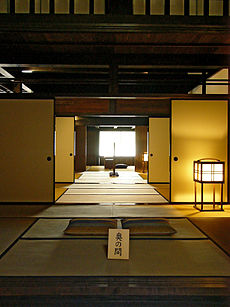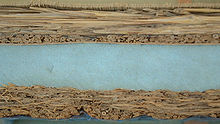|
The refreshing fragrance of tatami makes many of us feel relaxed and comfortable.
The soft but firm texture is perfect for walking on or for taking a nap.
Traditional Japanese culture and sports cannot do without tatami; in tea
ceremony, for example, where everyone is subject to the strict rules of
etiquette, the host and guests know where to sit or where to place the
t ea utensils based on how many meshes they are away from the border of the
tatami. Judo is practiced on tatami specifically made for sports. Without
tatami, neither of these could have developed into their present form. ea utensils based on how many meshes they are away from the border of the
tatami. Judo is practiced on tatami specifically made for sports. Without
tatami, neither of these could have developed into their present form.
Tatami consists of
three components;
① Surface
material : tatami-omote
The surface of tatami is covered with
tightly woven rushes called tatami-omote.
Over 4,000 rushes are woven into a tatami-omote. The old English expression “not worth a rush” means “of no value”, but
for the Japanese a rush has been very useful and valuable. Rushes have
a tough outer cover, and the inside is filled with sponge-like fiber. The
spongy substance contributes to creating the unique texture of tatami.
② Inner
core : tatami-doko
The core of tatami is traditionally made of rice straw and is about 5.5 centimeters thick. The rice straw core offers proper
firmness and allows air to pass through it, but nowadays compressed wood
chip boards and polystyrene foam are more common. That’s partly because
the new materials are lighter than the rice straw, which, in addition,
have become difficult to obtain since the mechanization of harvesting. straw and is about 5.5 centimeters thick. The rice straw core offers proper
firmness and allows air to pass through it, but nowadays compressed wood
chip boards and polystyrene foam are more common. That’s partly because
the new materials are lighter than the rice straw, which, in addition,
have become difficult to obtain since the mechanization of harvesting.
③ Border
material : tatami-beri
In order to bind the core to the surface,
fabric called tatami-beri is attached
to the edges. Its color and design used to be regulated in accordance with social
position and family status. The fact that tatami-beri
indicated a family’s social status was one of the reasons why stepping on it was
considered bad manners. Today we can choose whichever design we like to enjoy the
visual accent.
Tatami was originally used in the Heian period as seating or bedding on
wooden floors for the highest aristocrats. In the Muromachi period, with
the rise of shoin-zukuri architectural style, tatami gradually became used
to cover the whole surface of a room. It was around the end of the 17th century that tatami
finally reached the homes of commoners and became part of people’s daily lives.
As the Japanese styles of living are westernized, however, houses built today don’t
have as many tatami-floored rooms. The output of tatami-omote, including domestically produced and imported,
decreased by around 40% from 2004 to 2009. Tatami makers are developing a wide
variety of tatami which looks good in the modern interior, such as the tatami without
tatami-beri or the tatami-omote made of paper. Adjusting to the times, I’m sure tatami
will continue to be the indispensable item for Japanese life.
|
 ea utensils based on how many meshes they are away from the border of the
tatami. Judo is practiced on tatami specifically made for sports. Without
tatami, neither of these could have developed into their present form.
ea utensils based on how many meshes they are away from the border of the
tatami. Judo is practiced on tatami specifically made for sports. Without
tatami, neither of these could have developed into their present form.
 straw and is about 5.5 centimeters thick. The rice straw core offers proper
firmness and allows air to pass through it, but nowadays compressed wood
chip boards and polystyrene foam are more common. That’s partly because
the new materials are lighter than the rice straw, which, in addition,
have become difficult to obtain since the mechanization of harvesting.
straw and is about 5.5 centimeters thick. The rice straw core offers proper
firmness and allows air to pass through it, but nowadays compressed wood
chip boards and polystyrene foam are more common. That’s partly because
the new materials are lighter than the rice straw, which, in addition,
have become difficult to obtain since the mechanization of harvesting.